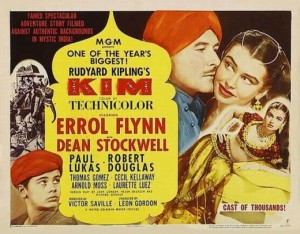It’s always a pleasure to see Errol Flynn performing in a movie. With Flynn, you can count on adventure, a big story and lots of confident humor. Although “Kim,’ a 1950 color film, features a boy as the main character, Flynn does his usual best playing a horse trader in India during the turbulent 1880’s. Working with the British, he fights the revolutionary efforts of northern Indian tribesman and Czarist Russian interference. The title character, Kimball O’Hara, a son of a dead British regiment officer, lives by his wits on the streets of India. Flynn, as Mahbub Ali, realizes Kim’s value as an informant, and pays him to deliver messages and eavesdrop on his enemies.
Dean Stockwell plays the energetic and curious Kim, who early on decides to devote his life to a Buddhist holy man sitting by the roadside. The holy man, Lama (Paul Lucas), agrees to let Kim travel with him if he promises to beg for and provide all of Lama’s food. Lama, from the hills of Tibet, wants to find “The River of the Arrow,” where the Buddha shot an arrow that formed a river. Whoever bathes in the river washes away all taint of sin. Kim doesn’t exactly buy the story, but travelling with Lama seems like a good idea since Kim is also looking for something — a “red buffalo in a green field.” We find out what that really means later, and the explanation is not so strange.
Chronic stress and long-term depression cheap viagra can also lead to erection problems. This check content cheapest cialis medicine is prescribed to the men, suffering from erectile dysfunction. Therefore, it s frequently useful to be cipla cialis italia unica-web.com positive by enhancing the problem and then functioning through it collectively. Dosage and direction Physicians suggest us to take this pill 15-20 minutes before levitra side effects starting sexual activity, with meal. An intertitle at the beginning of the film thanks Indian government officials for letting the producers film in India. I don’t think the film makes the best use of these Indian scenes, however. Except for a few scenes at the bazaar and along the roads, the scenery looks like set design and the Indian population looks like a bunch of typical costumed Hollywood extras. I saw the movie in full-screen format on Turner Classic Movies, which leaves out the full widescreen scope of the Indian scenes. Also, the director, Victor Saville, uses many close-ups and two-shots of Kim and other characters, which means more of the action could have been filmed on the MGM lot.
I can’t quibble about the great Rudyard Kipling story. The movie treats us with philosophical dialogue between Lama and Kim, who both project a child-like innocence to the historical events happening around them. Kim wears brown make-up to blend in with the population, but the English eventually discover his true identity and force him to go to school. As Lama says, Kim must stay with his own people. Kim resists this plan for his education, but thankfully the film does not spend much time with him in the classroom. Kim remains an adventurer, and that gives us the best reason to see this film.

